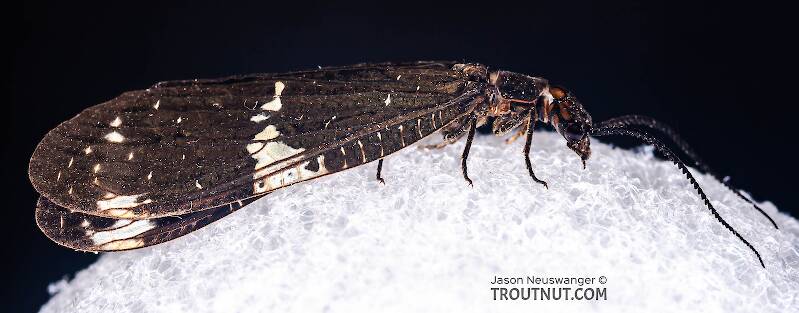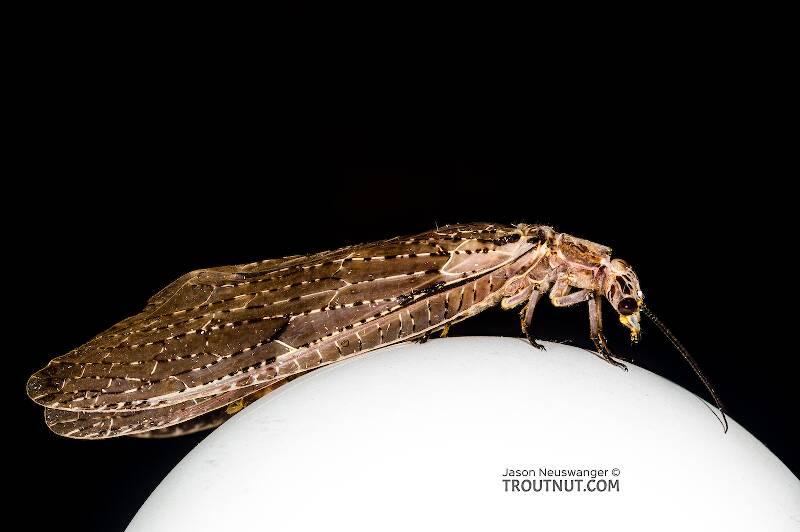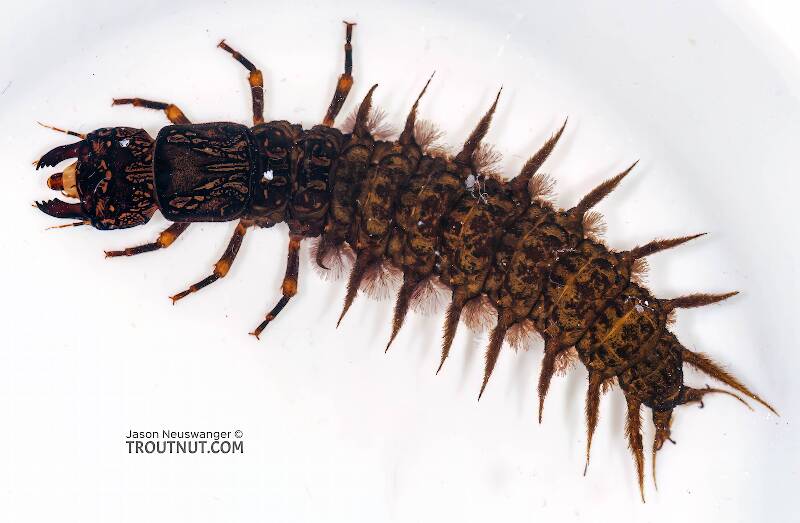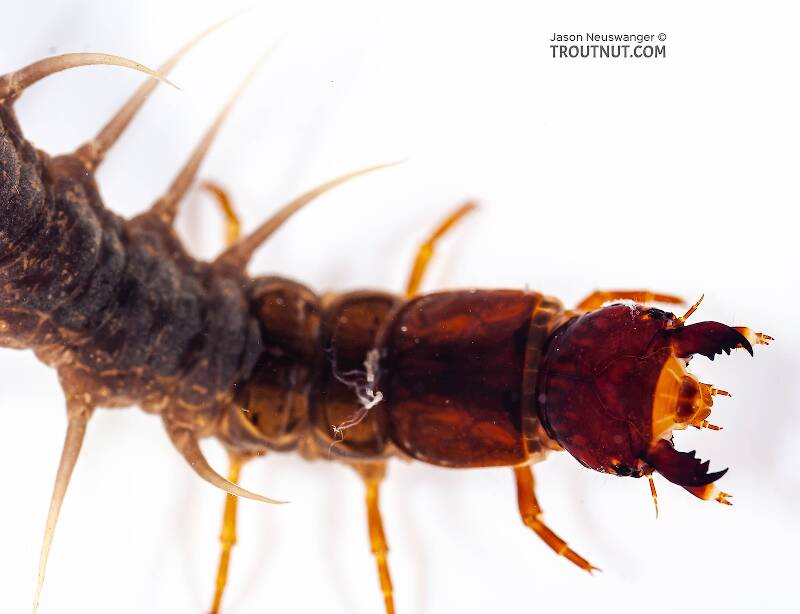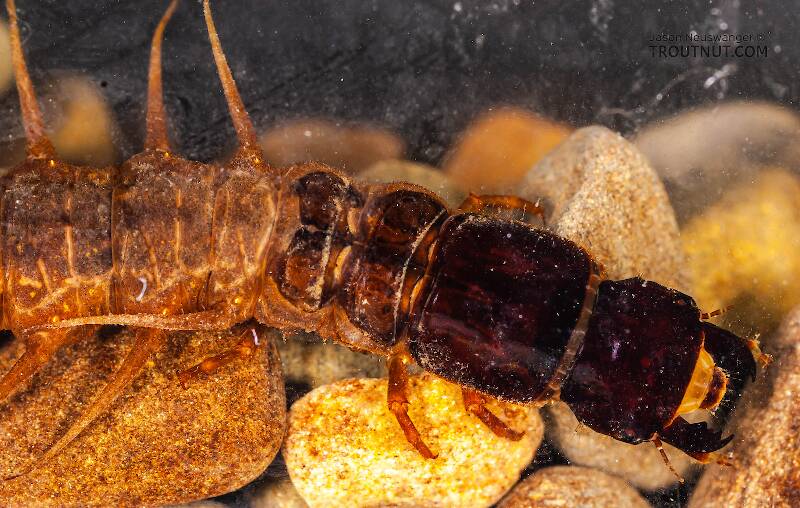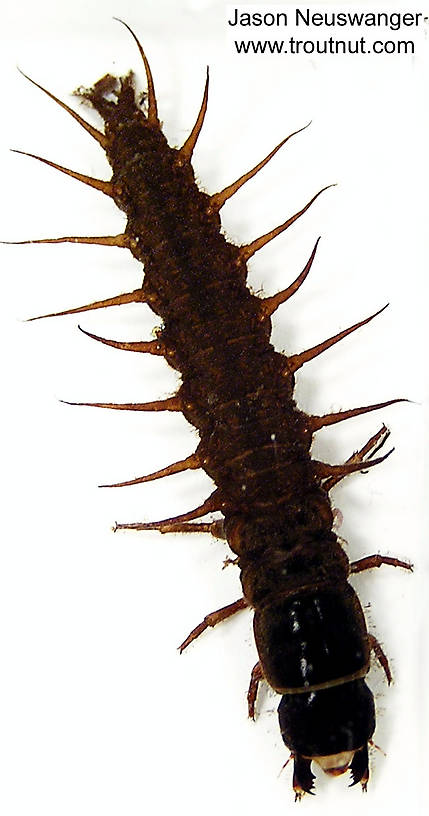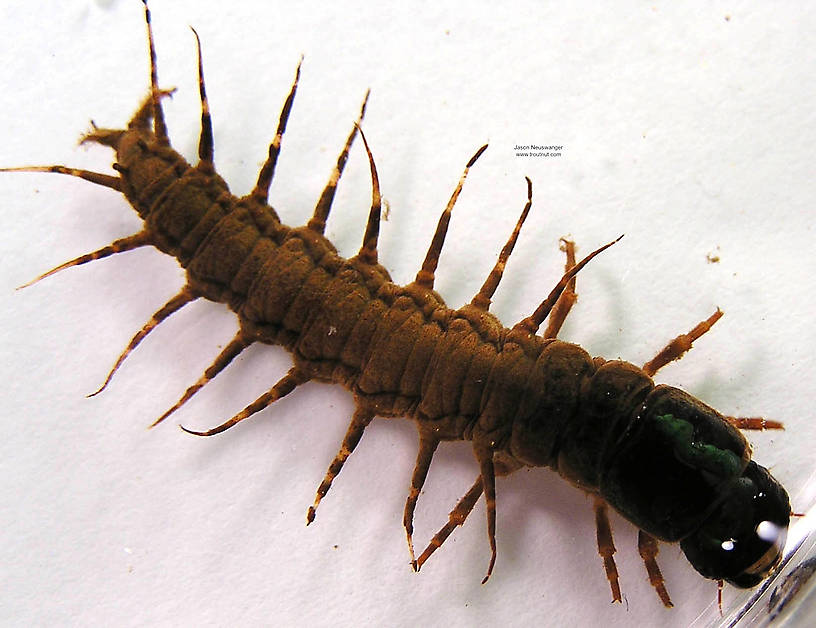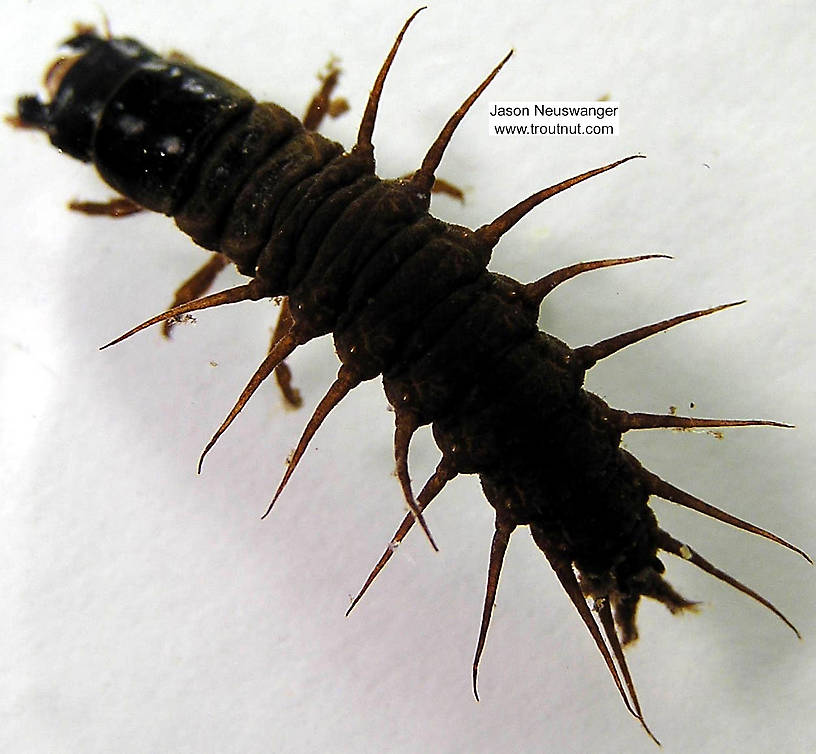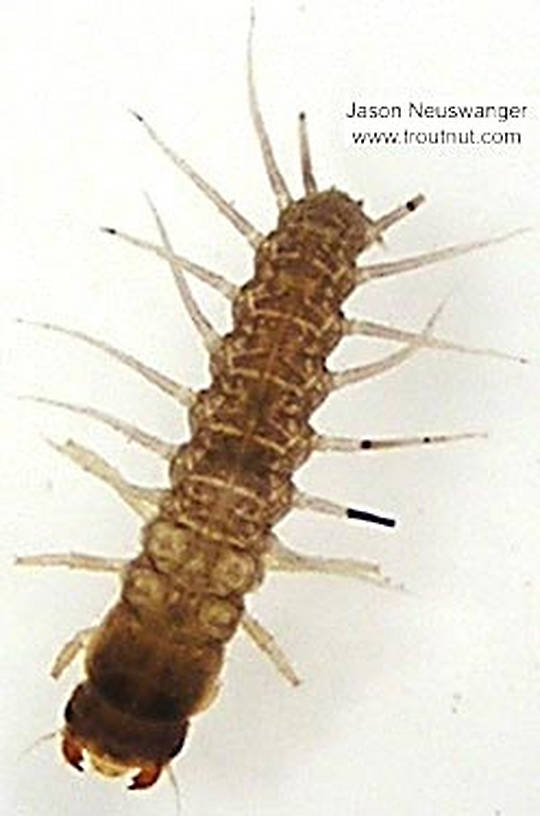
Blue-winged Olives
Baetis
Tiny Baetis mayflies are perhaps the most commonly encountered and imitated by anglers on all American trout streams due to their great abundance, widespread distribution, and trout-friendly emergence habits.
Featured on the forum

Troutnut is a project started in 2003 by salmonid ecologist Jason "Troutnut" Neuswanger to help anglers and
fly tyers unabashedly embrace the entomological side of the sport. Learn more about Troutnut or
support the project for an enhanced experience here.
Insect Family Corydalidae (Hellgrammites)
Hellgrammites are the vicious larvae of the Dobsonflies, some of the only trout stream insects which pose a biting threat to the angler. The pincers of the adult are even more frightening that the larva's, and they're aggressive enough to use them once in a while.
This family's life cycle does not create good dry fly opportunities, but the larvae may be eaten by trout year-round. They are a secret told only by stomach samples of well-fed trout.
This family's life cycle does not create good dry fly opportunities, but the larvae may be eaten by trout year-round. They are a secret told only by stomach samples of well-fed trout.
Where & when
In 1001 records from GBIF, adults of this family have mostly been collected during July (22%), June (21%), May (15%), August (13%), September (7%), and April (6%).
In 165 records from GBIF, this family has been collected at elevations ranging from 3 to 12631 ft, with an average (median) of 2510 ft.
Family Range
Hatching behavior
The larvae exit the stream to pupate in burrows in the ground, so their emergence is completely unimportant to trout.Egg-Laying behavior
Egg-laying dobsonfly adults are never, in my experience, common enough on trout streams to cause any sort of rise, but they are the sort of huge meaty insect that trout are unlikely ot pass up.Larva & pupa biology
I do not know how hellgrammites become available to trout, exactly -- perhaps by accident and perhaps they undergo behavioral drift. They are such large insects and they show up in trout diets often enough that imitations make good searching patterns. In fact, the infamous wooly bugger and wooly worm fly patterns probably owe some of their success to their similarity to hellgrammites.Specimens of Hellgrammites:
1 Male Adult
1 Female Adult
7 Larvae
Discussions of Corydalidae
Best time of year to harvest hellgramites
13 replies
Posted by Rblouser on Jun 27, 2008
Last reply on Jun 11, 2019 by Sapperstyle
I have just recently started fishing with hellgies and need some info on the best time of year for catching, bait. Any insight will be greatly appreciated
Dobson Fly
26 replies
Last reply on Sep 12, 2013 by PaulRoberts
What can anyone tell me about the Dobson Fly?
(General now guys, we don't have to go all scientific with it ha)!
(General now guys, we don't have to go all scientific with it ha)!
Anyone have hellgrammite experiences to share?
56 replies
Posted by Troutnut on Nov 18, 2006
Last reply on Aug 23, 2013 by Trout_House
I'm working on a magazine article about hellgrammites, which I think are a generally underrated food source and an extremely cool group of insects.
I'm going to do a lot of research and combine it with my own experiences, but many of you have been fly fishing longer than I've been alive, so I'd like to see if any of you have stories about them -- catching big trout with stomachs full of them, finding trout rising to the dobsonfly adults, getting bit by these bugs, or anything else.
I'm going to do a lot of research and combine it with my own experiences, but many of you have been fly fishing longer than I've been alive, so I'd like to see if any of you have stories about them -- catching big trout with stomachs full of them, finding trout rising to the dobsonfly adults, getting bit by these bugs, or anything else.
Fishfly is not a hellgramite
5 replies
Posted by Ofieldstrea on Jun 24, 2007 in the genus Nigronia
Last reply on Jun 28, 2011 by PaulRoberts
Troutnut ... the term "hellgramite" is reserved for the Dobsonfly (Corydalinae). Though the Fishfly (Chauliodinae) and the dobsonfly are from the same Megaloptera family, at first glance appear similar, and have similar stages of development, they are from different subfamily with differing subspecies and have very different morphology and biology.
The dobsonfly inhabit the more oxygenated waters of riffles and possess only tuffed gills for respiration. The fishfly inhabit the quiter waters of pools and still water. Fishflies have a primative gills called lateral filaments, while some species of fishfly utilize breathing tubes, located posterior, to accomodate the use of atmospheric oxygen for breathing in low dissolved oxygen envirions while remaining submerged.
So .. it is incorrect to use the term 'hellgramite' when talking about the fishfly larvae. They are simply, 'fishfly larvae'. You really should change your reference.
---- Reference -----
McCafferty, W. Patrick, 1981. Aquatic Entomology; Chpt. 11, Fishflies, Dobsonflies and Alderflies (order Megaloptera), p. 189-196
--------------------------
O'fieldstream
The dobsonfly inhabit the more oxygenated waters of riffles and possess only tuffed gills for respiration. The fishfly inhabit the quiter waters of pools and still water. Fishflies have a primative gills called lateral filaments, while some species of fishfly utilize breathing tubes, located posterior, to accomodate the use of atmospheric oxygen for breathing in low dissolved oxygen envirions while remaining submerged.
So .. it is incorrect to use the term 'hellgramite' when talking about the fishfly larvae. They are simply, 'fishfly larvae'. You really should change your reference.
---- Reference -----
McCafferty, W. Patrick, 1981. Aquatic Entomology; Chpt. 11, Fishflies, Dobsonflies and Alderflies (order Megaloptera), p. 189-196
--------------------------
O'fieldstream
trying to figure out
1 replies
Posted by Buggy on Apr 19, 2009
Last reply on Apr 19, 2009 by GONZO
I am from ontario canada and i pick hellgrammites for a local bait shop owner i was just wondering when is the earliest i could start picking...last year i started in june but i hear you can start sooner when is the earliest i can do this??? thanks for your help
serious picker
serious picker
Start a Discussion of Corydalidae
References
- McCafferty, W.P. 1983. Aquatic Entomology: The Fishermen's Guide and Ecologists' Illustrated Guide to Insects and Their Relatives. Jones and Bartlett Publishers.
- Merritt R.W., Cummins, K.W., and Berg, M.B. 2019. An Introduction to the Aquatic Insects of North America (Fifth Edition). Kendall/Hunt Publishing Company.
- Schwiebert, Ernest G. 1955. Matching the Hatch. MacMillan Publishing Company.
Insect Family Corydalidae (Hellgrammites)
Taxonomy
4 genera (Dysmicohermes, Neohermes, Orohermes, and Protochauliodes) aren't included.



